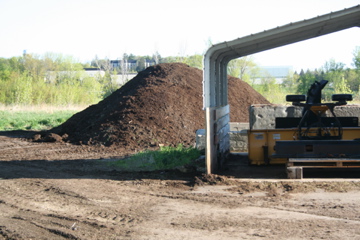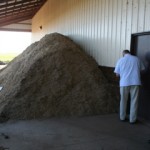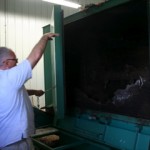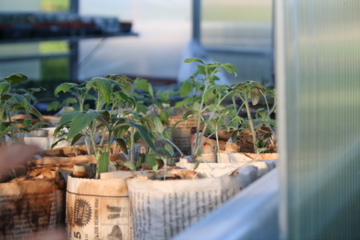 See the pile of compost in the image at left? That pile represents all of the food waste from St. Olaf College from a year. Amazing.
See the pile of compost in the image at left? That pile represents all of the food waste from St. Olaf College from a year. Amazing.
I was one of a dozen or so University of Minnesota-Extension Master Gardeners from Rice County who had a chance to tour St. Olaf’s composting facility, its student farm, and its food-service operations last week. We were led by St. Olaf Facilities Director Pete Sandberg and Peter Abrahamson, general manager of the food service and former executive chef at the college.
With about 2,650 students plus faculty, staff and visitors (St. Olaf has a well-deserved reputation as one of the best places in Northfield to eat), the school serves about 32,000 meals a week and generates 700 pounds a day of food waste, including meat, dairy, napkins and other compostibles. The system that St. Olaf uses to take leftover pizza, hamburger buns and banana peels and turn them into garden gold is efficient, high tech and helps the college in its efforts to reduce its impact on the environment.

OK, not the prettiest picture ever put on this blog, but this is what the food waste looks like as it goes to the composter.
When students return their trays to the college dishwashing area, all the compostibles are collected and ground to a pulp. The liquid is taken out of the waste and every day St. Olaf facilities workers take the pulp out to the compost facility, which is located on St. Olaf land near the Northfield Hospital.

As Pete Sandberg unlocks the door, Peter Abrahamson explains the food to compost cycle. That pile of wood chips provides dry, brown matter to compost with the food waste.
At the facility, the food waste (a green for composting purposes) is mixed with wood chips (a brown), and over the course of 14 to 21 days, it moves slowly through a large composting machine. The interior of the composting facility has what Sandberg called “a barn smell,” but other than that the process is relatively odor-free.
After its time in the composter, the mostly finished compost is moved outside to piles. It’s still very hot inside and the composting process continues in these piles, where the compost will sit for several months to a year as it finishes cooking. The facilities workers turn the compost regularly using backhoes to keep the piles going.
Once it is finished cooking, the compost is used all over St. Olaf’s campus — in the flower beds and containers, as well as on the St. Olaf student farm, STOGROW. Bon Apetit, the food services provider at the college, buys all of the vegetables produced at the student farm and uses them in meals during the growing season.
St. Olaf has received national attention for its efforts to reduce its impact on the environment. The school’s composting, farming, and food service programs allow it to “close the circle,” as Abrahamson said, using waste from food to grow more food. While these kinds of systems are not available to home gardeners, increasingly institutions are taking composting seriously and finding better ways to make compost on a grand scale.


Very cool!
Nice! Does this system process meat scraps too? I’ve read that meat is too hard to compost in a private garden composter, but I guess this is more high tech then?
Thomas — Yes, the St. Olaf system takes meat and dairy, things home gardeners really should not compost. These are industrial sized, contained composting facilities. They’re great for institutions, like colleges and schools.